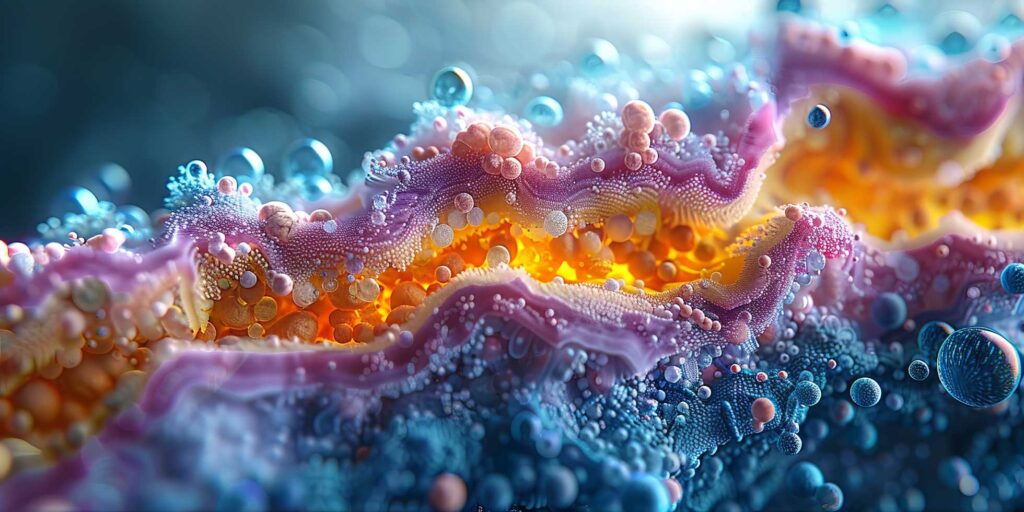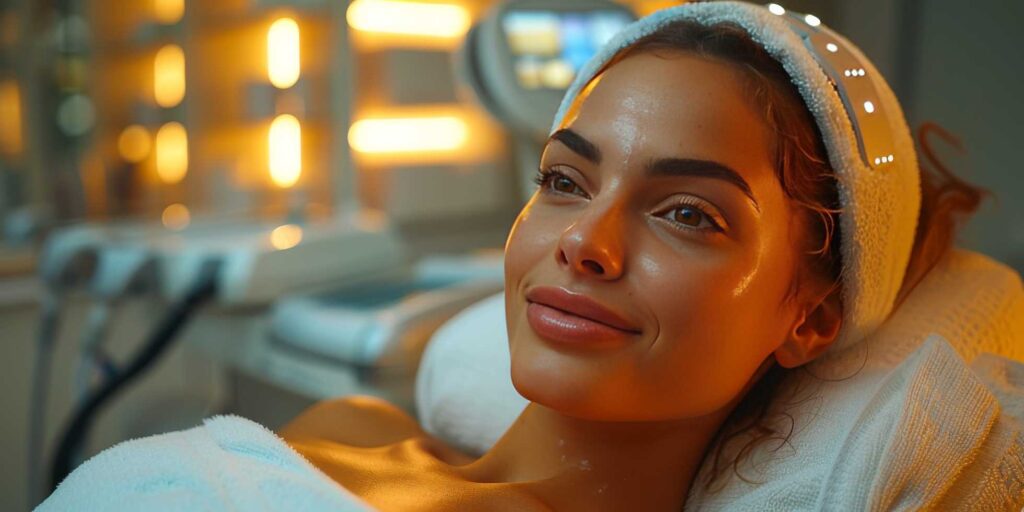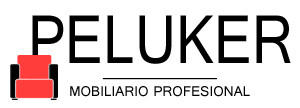Introduction to Facial Radiofrequency
Facial Radiofrequency has become one of the most sought-after aesthetic treatments in recent years. This non-invasive technique uses electromagnetic energy to heat the deep layers of the skin, stimulating the production of collagen and elastin. The result is firmer, smoother, and rejuvenated skin.
In the competitive world of aesthetics, Facial Radiofrequency stands out for its effectiveness and safety. Aesthetic centers offering this treatment have seen a significant increase in demand, as clients seek non-surgical alternatives to combat signs of aging.
The technology behind Facial Radiofrequency has evolved considerably since its introduction to the market. Modern equipment allows for precise control of temperature and penetration depth, ensuring optimal results and minimizing risks.
One of its most attractive aspects is its versatility. It can be applied to different areas of the face and neck, adapting to the specific needs of each patient. From reducing fine lines to improving facial contours, this treatment offers personalized solutions.
In this article, we will address the most frequently asked questions, providing detailed and up-to-date information for those considering undergoing this treatment or simply wishing to expand their knowledge about this innovative aesthetic technique.

How Does It Work?
Operates under a fascinating scientific principle. It uses high-frequency electromagnetic waves that penetrate the deep layers of the skin, generating controlled heat. This heat, reaching temperatures between 40°C and 45°C, triggers a series of biological processes beneficial for the skin.
The first notable effect is the stimulation of collagen production. Collagen, a fundamental protein for skin elasticity and firmness, naturally begins to degrade from the age of 25. Radiofrequency activates fibroblasts, cells responsible for collagen synthesis, promoting the formation of new fibers and reinforcing existing ones.
In addition to collagen, also boosts elastin production. This protein, crucial for skin flexibility, works in synergy with collagen to improve the overall texture and appearance of the skin. The result is more elastic skin that’s resistant to wrinkle formation.
Another significant benefit of radiofrequency is its effect on blood circulation. The generated heat dilates capillary vessels, increasing blood flow in the treated area. This not only improves tissue oxygenation but also facilitates the elimination of toxins and metabolic waste.
The Beauty Devices used in Facial Radiofrequency have evolved to offer increasingly precise and effective treatments. Modern equipment features real-time monitoring systems that allow adjusting the intensity and duration of the treatment according to each patient’s specific needs, ensuring optimal and safe results.

Benefits
Facial Radiofrequency offers a wide range of benefits that have made it one of the star treatments in aesthetic centers. One of the most notable is its ability to tighten and firm the skin. By stimulating collagen and elastin production, a visible improvement in skin firmness is achieved, reducing sagging and giving a more youthful appearance.
Another significant benefit is the reduction of wrinkles and expression lines. Radiofrequency acts on both superficial and deep layers of the skin, smoothing existing wrinkles and preventing the formation of new ones. This effect is particularly noticeable in areas prone to showing signs of aging, such as the eye contour and the perioral area.
Improvement in skin texture is another positive result of Facial Radiofrequency. The treatment promotes cell renewal and improves microcirculation, resulting in smoother, more luminous skin with a more uniform tone. Many patients report a notable improvement in the appearance of dilated pores and mild scars.
Facial Radiofrequency is also effective in treating double chin and neck sagging. These areas, which are often difficult to treat with other non-invasive methods, respond well to radiofrequency, achieving a more defined facial contour and a younger appearance.
An additional benefit, less known but equally valuable, is its effect on sebum production. Radiofrequency can help regulate the secretion of sebaceous glands, which is beneficial for oily-prone skin or those with acne problems.
Frequently Asked Questions
1. Is Facial Radiofrequency suitable for sensitive skin?
Can be suitable for sensitive skin, but it requires prior evaluation by a professional. In these cases, the treatment intensity can be adjusted and specific calming products can be used to minimize any irritation.
2. Can I exercise after a session?
It is recommended to avoid intense exercise for 24 hours following the treatment. The increase in temperature and sweating could irritate the treated skin. After this period, normal physical activity can be resumed.
3. Does Facial Radiofrequency help with skin spots?
Although Facial Radiofrequency is not specifically designed to treat spots, it can improve the overall skin tone. To address specific spots, it is more effective to combine it with other treatments such as IPL or chemical peels.
4. Is it normal to feel tight skin after the treatment?
Yes, it is normal to feel slightly tight skin after. This sensation is usually temporary and is a sign that the treatment is stimulating collagen production.
5. How long should I wait between Facial Radiofrequency and other aesthetic treatments?
The waiting time depends on the type of treatment. In general, it is recommended to wait at least a week between radiofrequency and other facial treatments. However, it is best to consult with a professional for a personalized recommendation.
6. Can Facial Radiofrequency help with acne?
Although it is not a specific treatment for acne, Facial Radiofrequency can indirectly help by regulating sebum production and improving skin texture. For active acne cases, it is better to combine it with other specific treatments.
7. Can I use anti-wrinkle creams after Facial Radiofrequency?
Yes, but it is important to follow the specialist’s recommendations. Generally, you can resume using anti-wrinkle creams 24-48 hours after the treatment, as long as they do not cause irritation.
8. Does Facial Radiofrequency affect facial hair?
Facial Radiofrequency is not designed to affect facial hair and should not cause significant changes in its growth or appearance.
9. Is it possible to combine Facial Radiofrequency with Botox or filler treatments?
Yes, it is possible to combine these treatments, but it is crucial to follow the proper order and waiting times. Generally, it is recommended to perform radiofrequency before Botox or fillers, or wait at least two weeks after these procedures.
10. Can Facial Radiofrequency help with dark circles?
Radiofrequency can improve the appearance of dark circles by tightening the skin and improving circulation in the area. However, for optimal results in this delicate zone, it is often combined with other specific treatments.
11. Is Facial Radiofrequency safe during pregnancy or breastfeeding?
As a precaution, it is recommended to avoid during pregnancy and breastfeeding. It is better to wait until after this period to undergo the treatment.
12. What is the difference between monopolar and bipolar radiofrequency?
Monopolar radiofrequency penetrates deeper into the skin and is more effective for tightening, while bipolar is more superficial and is used for gentler treatments or in delicate areas.
13. Can Facial Radiofrequency worsen rosacea?
In some cases, radiofrequency could temporarily exacerbate rosacea symptoms. It is crucial to consult with a dermatologist before undergoing the treatment if you suffer from this condition.
14. Can I use Facial Radiofrequency if I have dental implants or metal plates?
In general, dental implants are not a contraindication. However, if you have metal plates in the treatment area, it is important to inform the specialist, as it may be necessary to adjust the protocol.
15. Can Facial Radiofrequency replace a skincare routine?
No, Facial Radiofrequency does not replace a good skincare routine. In fact, maintaining an adequate routine can enhance and prolong the results of the treatment.
16. Is it possible for it to cause sagging if overused?
There is no evidence that it causes sagging when used correctly. However, excessive or improper use could irritate the skin or decrease its effectiveness.
17. Can Facial Radiofrequency help with defining the facial oval?
Yes, it can be very effective in improving the definition of the facial oval by tightening the skin and stimulating collagen production in this area.
18. What is the recommended minimum age to undergo Facial Radiofrequency?
There is no strict minimum age, but it is generally recommended from the age of 30, when the first signs of aging begin to be visible. In younger people, it can be used for preventive purposes.
19. Can Facial Radiofrequency help with acne scars?
Facial Radiofrequency can improve the appearance of acne scars by stimulating collagen production and improving overall skin texture. However, for deeper scars, additional treatments may be necessary.
20. Is it normal to taste metal during the treatment?
Some people may experience a slight metallic taste during the Facial Radiofrequency treatment. This is harmless and usually disappears quickly after the session.
21. Can Facial Radiofrequency affect vision?
When applied correctly, Facial Radiofrequency does not affect vision. However, it is important to protect the eyes during treatment, especially when working in areas close to them.
22. Can I perform Facial Radiofrequency at home with over-the-counter devices?
There are radiofrequency devices for home use, but they are generally less powerful and effective than those used in professional centers. Additionally, without proper supervision, there is a higher risk of incorrect use.
23. Can Facial Radiofrequency help with double chin?
Yes, Facial Radiofrequency can be effective in improving the appearance of double chin by tightening the skin and reducing localized fat in this area.
24. Is it possible for Facial Radiofrequency to cause hyperpigmentation?
The risk of hyperpigmentation with Facial Radiofrequency is low when performed correctly. However, it is important to protect the skin from the sun after treatment to prevent this side effect.
25. How long should I wait to undergo a Facial Radiofrequency treatment after facial plastic surgery?
The waiting time after facial plastic surgery varies depending on the type of procedure, but it is generally recommended to wait at least 3-6 months. It is crucial to consult with the plastic surgeon before undergoing any additional aesthetic treatment.

Conclusion and Future Perspectives
Facial Radiofrequency has established itself as one of the star treatments in the world of non-invasive aesthetics. Its ability to stimulate natural collagen and elastin production, along with its safety and versatility, has made it a preferred option for both patients and professionals in the sector.
As technology continues to advance, we can expect to see even more significant improvements in the Beauty Devices used for Facial Radiofrequency. These innovations will likely focus on increasing treatment precision, improving patient comfort, and optimizing results.
An emerging trend is the combination with other technologies in a single device. These multifunctional machines could offer more comprehensive and personalized treatments, addressing multiple aspects of skin aging in a single session.
Ongoing research in the field of cellular regeneration and collagen stimulation could lead to more effective and long-lasting treatment protocols. This could result in longer intervals between maintenance sessions and even more impressive results.
In conclusion, this treatment remains at the forefront of non-invasive aesthetic treatments. Its proven effectiveness, combined with continuous innovation in the field, ensures that it will continue to be a popular option for those seeking to rejuvenate their skin naturally and safely. As always, the key to obtaining the best results lies in choosing a trusted aesthetic center and following the recommendations of trained professionals.



